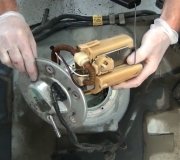A simple trick to finding a short is to replace the blown fuse with a pair of spade terminals, then use small jumper wires to connect them to a twelve volt light bulb. A brake light bulb works well. When the circuit is live and the short is present, the bulb will be full brightness and hot so be sure it is not laying on the carpet or against a plastic door panel. Now you can unplug electrical connectors and move things around to see what makes the short go away. When it does, the bulb will get dim or go out.
For intermittent problems like yours the bulb may be dim already. Watch what takes place when it gets bright. That is when the short is occurring. It could be due to the rocking of the engine when you shift between reverse and drive. It could be due to the body flexing when you drive over bumps in the road. The bulb limits current to a safe value when the short occurs, in this case about one amp. The circuitry is likely to not work properly with a brake light in the circuit because it limits current too much, Try a headlight bulb instead of the brake light bulb. The low beam filament will limit current to five amps, and the high beam filament will allow about six amps to flow.
With no other observations to go on yet, may I suggest that a lot of blown fuses are caused by charging phones and things like that from the cigarette lighter socket. While they will work, those are designed with special contacts for lighter elements. Often the regular contact on the side of the plugs will touch the safety cutout contact if that plug is inserted just right. You will see the test bulb get bright when you insert the charger plug if that is what's causing the blowing fuse.
SPONSORED LINKS
Thursday, May 24th, 2018 AT 6:27 PM



